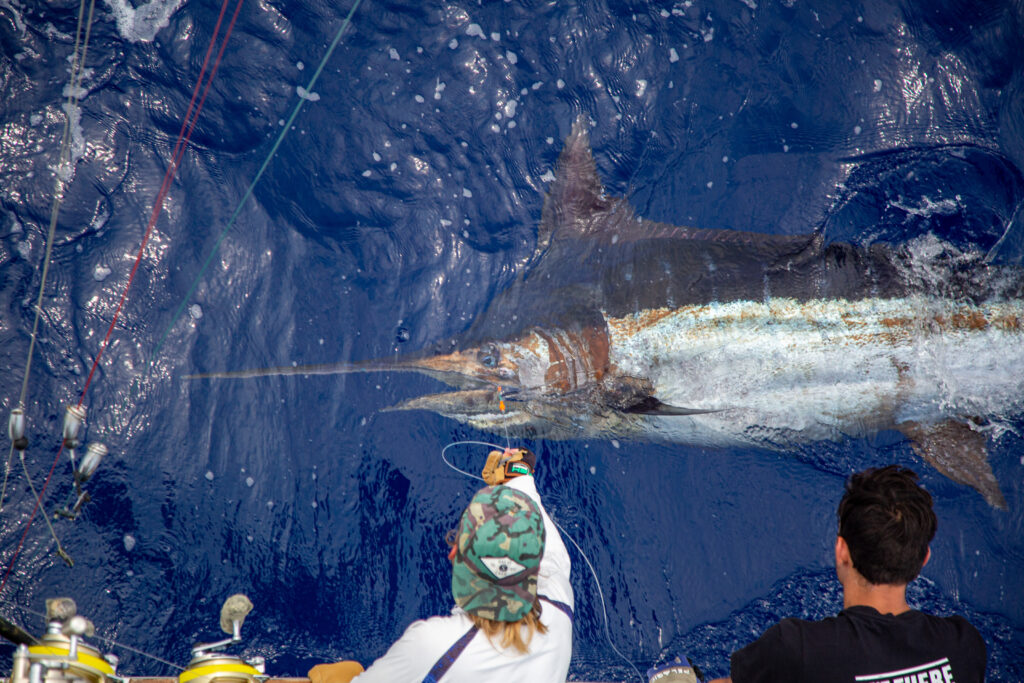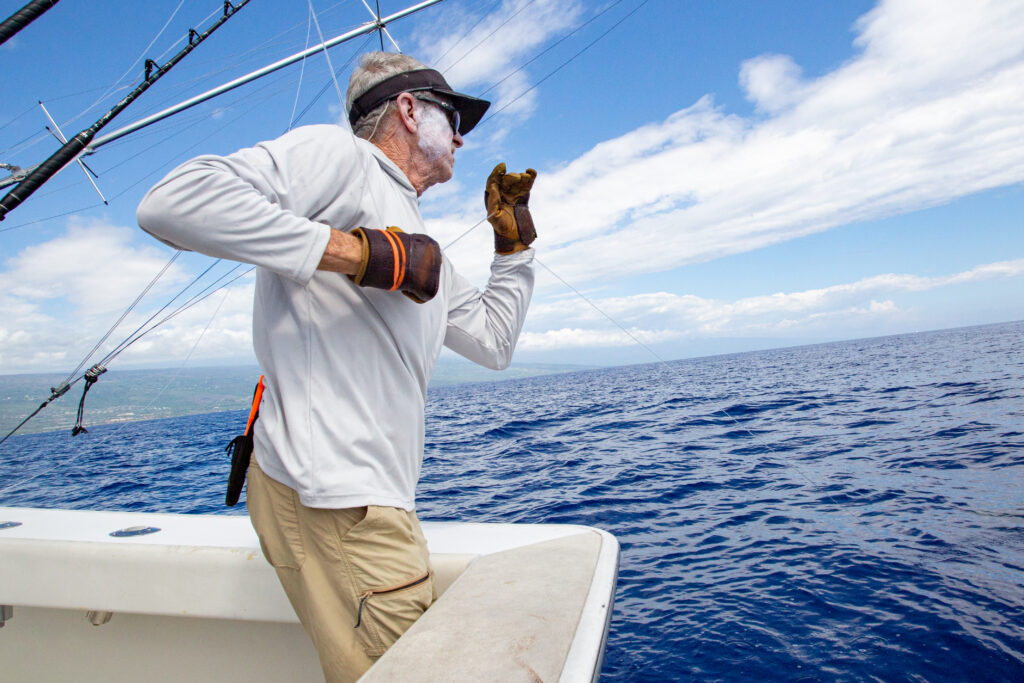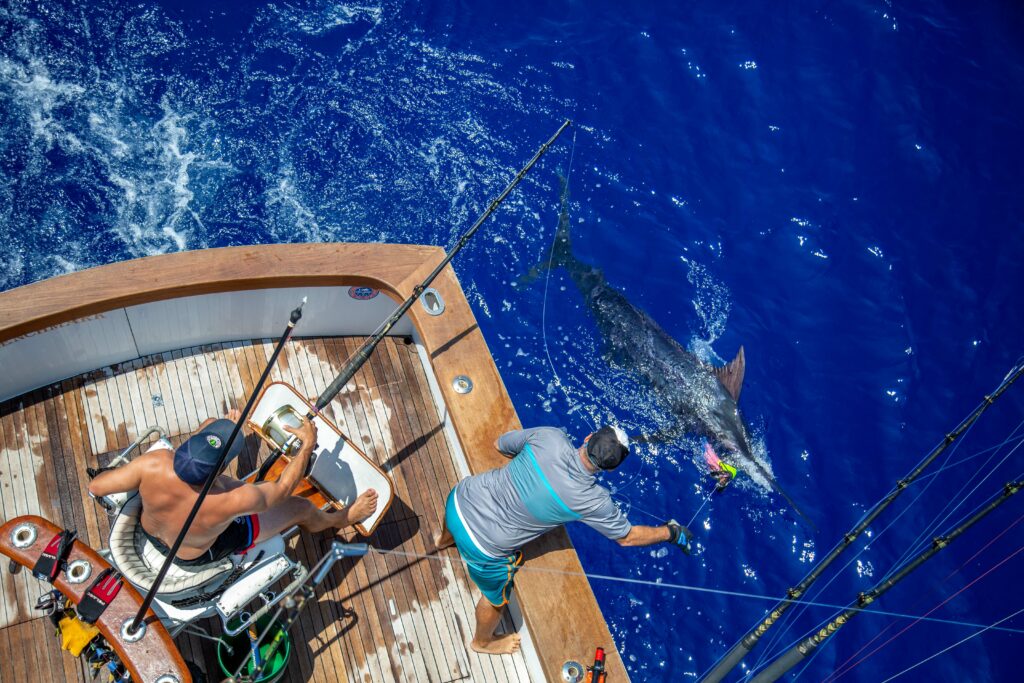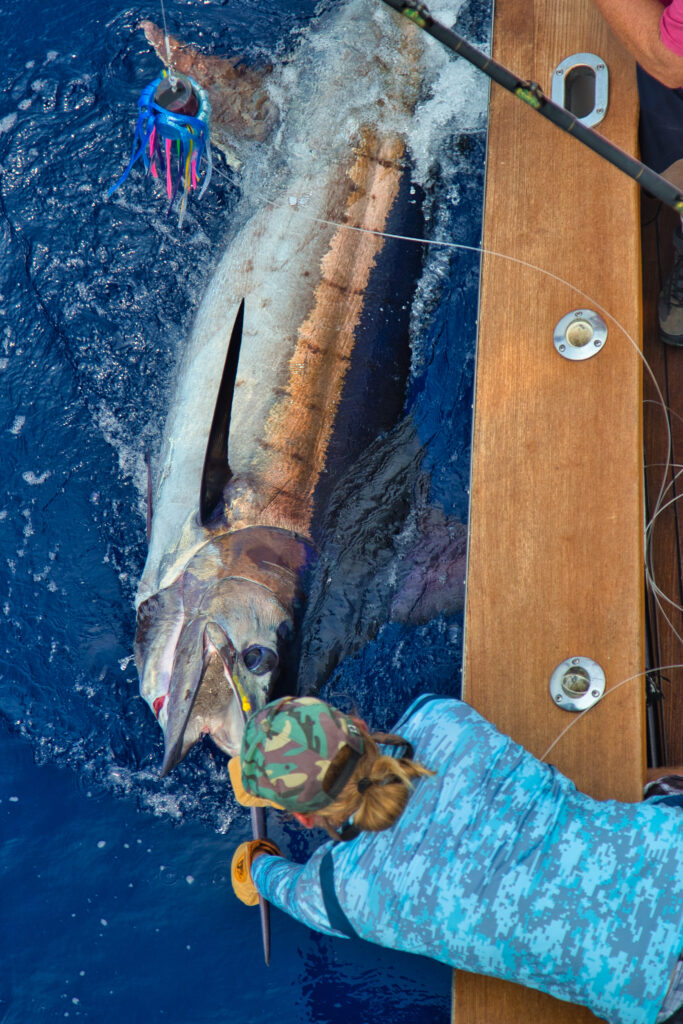Safely Bringing a Marlin Boatside
For crewmen like myself, all the hours spent preparing tackle, cleaning boats, dealing with charter clients and staring down a trolling spread leads up to one light at the end of the tunnel: leadering marlin to get the primal man versus fish feeling of pulling on a big marlin in close quarters. It’s a responsibility that mates crave but also shouldn’t be taken lightly, as mistakes can escalate quickly and the consequences can be grave. I remember being at the Big Rock weigh station years ago and finding out that experienced mate Chris Bowie was killed after being pulled over by a foul-hooked blue marlin the crew had tagged to release. Experts like Peter B. Wright analyzed the video taken that day and didn’t find anything glaring that Bowie did wrong that led to the incident. As a young fishing-obsessed kid, it stuck with me that the worst outcome can even happen to the pros and there was a lot more to wiring a fish than grabbing the leader and pulling as hard as you can.
Table of Contents
Teamwork Makes the Dream Work
Much is made about the wraps themselves. It’s for good reasons, that we’ll get into later, but being adequately prepared on the leader starts before you put your gloves on. Bo Jenyns, a world wide experienced Australian wireman and creator of Obadu wiring gloves, insists that communication between the captain and leaderman is crucial.
“The guy on the wheel is really the main one you’re counting on to keep you safe,” Jenyns says. “If I’m fishing with a captain for the first time, I think it’s really important to talk with them about how you wire and how they drive on a fish. I like to go over certain scenarios and even things like where they want me to stand or if they prefer me in a certain corner of the cockpit. You’ve got to make sure you’re on the same page so the captain can look out for you.”

Making sure the angler is aware of what to do as the endgame nears is another aspect that can often be overlooked. Charles Perry is an IGFA Hall of Famer and a legend among wiremen, with 28 grander marlin weighed and even more released in his career. He agrees that communication is paramount to success and safety on the leader.
“You want the angler to understand the whole process: they should back off the drag to an appropriate mark when you get the leader, wind slowly to the swivel so you don’t get wound up (line wrapping around the tip of the rod) and then increase the drag back where it was if the leader has to be dumped,” Perry explains.
Backing off the drag after the wireman takes wraps keeps the angler from getting jerked if the leader must be dumped, and getting the swivel to the rod tip prevents tip wraps from loose line hanging. We’re often able to grab the leader before the angler reels the swivel to the rod tip, and there’s almost no worse feeling than taking wraps and then getting wound up by the angler. Make sure the angler knows they should give you a little space and not reel your hand tight. Especially in charter situations or with inexperienced anglers, it’s important that the angler understands the situation and what the wireman requires of them. And while I like to go over leader situations in my morning rundown, it always helps to reiterate information to the angler again during the fight because I’ve found that people tend to forget previous instructions in the excitement of the battle.
“You want to talk to everyone—captain, angler and your tag or gaff man—so they know what to expect and everyone is on the same page,” Perry explains. “Trust is really important, and if you’re with a captain and crew, you trust that everyone can just react to the fish without having to worry about what the other is doing. We’re already living dangerously with what we do, and trusting your team allows you to feel safer while pushing it closer to the edge.”

Gearing Up For Marlin Leadering
My current captain, Great Barrier Reef veteran Ross Finlayson, likes to say “it’s better to be looking at it than looking for it,” and that rings true when it comes to leadering. Being prepared to leader means having the right gloves and having them ready, wearing a belt with the adequate supplies (cutter, pliers, knife) and having grippy footwear. You don’t want to keep running back and forth to the chair or tackle station to get what you need. Keep these items on you so when things get crazy, you’re already prepared.
Choosing the Right Marlin Leadering Gloves
Choosing the right pair of gloves comes down to personal preference and tackle size, but I prefer leathers with suede covers for heavier tackle applications (400-pound leader and above) or cotton wiring gloves that have Kevlar reinforcement. I’m looking for the right mix of “feel” through the gloves when I have a fish on but also still keeping the protection of heavy material where the wraps will lay on the top of your hand and the outside edges of your palm to keep your hand from getting crushed. Bo Jenyns’ Obadu gloves come in both heavy and medium weight and are great options in leather, and Charles Perry’s Kevlar reinforced Fish Monkey Beastmaster gloves are great as well. With these and other purpose-driven products out there, I think the days of using bulky welding or fireman’s gloves to leader marlin should be behind us. They’re simply not as good and also make it harder to use cutters or other tools if necessary.
Marlin Leadering Tools on Your Belt
It’s also imperative that you have at least one release knife or good pair of cutters on your belt or somewhere that’s easily accessible when wiring fish. A bad situation on the leader happens in a fraction of a second, and you should have a way to cut yourself out if necessary. Jenyns also mentions that a second crew member should be prepared with a release knife if assistance is required. It’s a great idea to practice going for your release knife on your belt, pulling it out of the holster and pretending to reach out and cut yourself off to develop the muscle memory that it may require when the time comes that you actually need it. While holding the release knife in the mouth might be convenient, it takes away your ability to talk to the captain and crew. Not to mention, if you got yanked in it would either be tough to hang on to or cause you to get a big gulp of salt water.
Dont Overlook Your Footwear
Since your feet are the only thing keeping you in contact with the deck, good footwear shouldn’t be overlooked either. This is another personal preference thing, as I know guys that use everything from flip-flops to boots and everything in between. The main thing is that you have something that gets a solid grip on whatever deck material you’re working on, especially when it’s wet. It’s never a good idea to leader fish barefoot. It simply doesn’t create enough friction between you and the deck, plus it creates an opportunity to step on a hook that may be laying around. While we’re on the subject, be sure to clear the working area in the cockpit as much as possible before grabbing the leader. Get any buckets, ropes, loose leaders and other obstacles out of your way, and also be aware of things like fuel fills or deck hatches that you could potentially slip or trip on while you’re taking wraps. Anything that can go wrong usually will at some point, so take all the preventative measures you can to minimize risk.
Look, React and Wrap: Techniques for Leadering Marlin
So now, on to the fun part, actually getting hold of the leader. Ideally, you want to get the leader and move to whichever side of the cockpit the fish is nearest. Try to start in a good athletic position with your knees bent and thighs pressed against the side of the covering boards for stability. Paying attention to the way the fish has acted during the fight can help you anticipate how it may act on the leader. Get as much information as you can by watching the fish to see where it’s hooked, or which side of the mouth, and try to anticipate or stay ahead of its movements. A foul hooked or tail-wrapped fish is an especially dangerous one since it’s not being pulled from the front. Therefore, be ready to dump the leader a bit quicker if this is the case.

I like to make my first pull on the leader by grabbing it and pulling it down to my chest before I take wraps to see how the fish reacts. If you try to match the pressure that was on the fish from the drag previously, you may be able to gain line without the fish having much of a reaction from the difference in pressure applied.
“I want to react to how the fish is pulling,” Jenyns says. “Sometimes if the fish is coming up nice and easy you can just ease him up without pulling too hard and almost sneak up on them without changing the weight and causing a reaction. Whereas, if he’s pulling hard, and going away I’m going to pull hard and try to rip his head off. But a lot of times you’re better off not pulling as hard as you can just to show that you’re a wireman.”
While every fish is different, both Perry and Jenyns said in a normal situation they liked to pull down on the leader and then get a pinch and a backhand wrap first so they have a good hold on the fish early. You must keep bringing your arms back towards your chest and keep your elbows bent, so the leader is close to your body, almost like in a boxing stance. If you’ve got your arms fully extended with wraps, then you’re not in an advantageous position.
“A lot of people have trouble with the backhand because they learn the overhand first and want to do all the high arm swings with the leader. But all your strength comes from your core,” Perry says. “You can pull a lot more from your chest and core, which allows you to control a fish that’s much stronger than you are. If your arms are completely extended and you’ve still got wraps, then you should probably think about dumping it, because you’ve got no strength there. If the fish shakes its head and your arms are locked, it can rip you over the side or hurt you in that position.”

Utilizing Overhand and Backhand Wraps
All the great wiremen I know utilize both types of wraps: the overhand wrap (or forehand wrap) and the backhand wrap (or tuna wrap). Both have their purposes, but when the line is tough to gain, the backhand is often your only option. Perry also mentions that utilizing the backhand wrap can save your shoulder, as well as your energy since it doesn’t require the shoulder leverage that the overhand does. Perry stresses the need to practice the backhand wrap so that it comes naturally to you on the leader. He coaches his students in Marlin U to get used to taking a backhand wrap even on small gamefish so that when the time comes to leader a marlin, they can perform it by instinct.

Knowing When to Let Go
Smaller fish have a tendency to flip on the leader and can become a liability by flying into the cockpit. If you’re fully extended in your reach and the fish is still pulling away, you’ve lost your position of advantage. Your tackle size should be kept in mind here as well. Even with heavy tackle, leaders can break and hooks can bend, but if you’re rigged with lighter tackle, you have to take your gear limitations into account. In situations like these, dumping the leader can be the right move. It’s also important to note that smaller fish can be just as dangerous. Marlin under 400 pounds are harder to telegraph and make moves with lightning quickness, so don’t let your focus slip on them either.
Conclusion: Safely Mastering Marlin Leadering
There’s nothing quite like pulling on a big marlin or tuna on the leader. It’s one of the most thrilling aspects of our sport, but also one of the most dangerous. Being prepared maximizes both the safety factor and the amount of fun you can have. Having the right gear, the proper communication amongst your team and honing your technique until its second nature will keep you safe and successful when you’re locked in hand-to-hand combat with the badest fish in the ocean.
Don’t Forget to Check Out Our Sportfishing Job Board! Did You Know? It’s the perfect platform for seeking skilled captains and mates. Whether you’re on the hunt for your dream team or looking to join one, your next big adventure begins here. Explore the opportunities now! Click Here
Unlock Your Next Sportfishing Career Opportunity
Are you ready to chart a new course in your sportfishing career? Stay ahead of the curve! Join our Job Board ‘Job Alerts’ and be the first to seize exciting job openings for captains and mates. Don’t let your dream job slip away – log in and sign up now! Click Here
Dive Deeper into the World of Sportfishing
Unlock Exclusive Savings: Enjoy 50% Off Your Subscription!
Are you ready to explore the thrilling world of sportfishing from the comfort of your home? Subscribe now and embark on a journey filled with captivating stories, expert insights, and insider tips. Choose between our digital or print edition and secure an incredible 50% discount on your subscription.
Subscribe today and get ready for an adventure like no other. Click here to subscribe and elevate your sportfishing experience with InTheBite Sportfishing Magazine.











